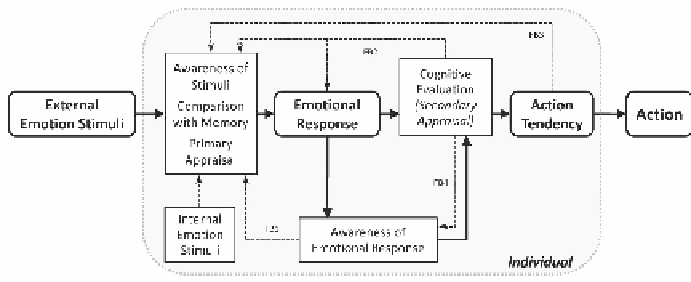Graphics Reference
In-Depth Information
experience satisfaction or joy. In a last step, the individual's coping
capabilities regarding situations are reviewed with regard to his or her
goals and plans. The basis for this assessment is a causal attribution,
i.e. the determination of what caused a certain stimulus. Without this
causal attribution, it is often not possible to assess coping capabilities.
If the individual cannot cope with the respective stimulus constellation
without putting his or her important goals at risk, the result is anger
or, in the event of habitual insufficiency, helplessness or depression.
Finally, the relevance for the individual's self-image is processed. In an
unfavorable case, it coincides with feelings of embarrassment, shame or
guilt. Also included in this complex stimulus processing is information
about the external stimulus, aspects of the self-image and especially
social norms. In total (possibly after some back and forth iteration),
this complex cognitive assessment leads to a determination of action
tendencies and ultimately actions. In this process, the importance of
the triggering stimulus may have changed.
The perceptions of the emotional response managed are not always
identical and sometimes are even conflicting action tendencies. An
emotional anger response may, for example, trigger action tendencies
to show the anger in one's face and body language. The individual
perceives this response and action tendency simultaneously, which
can block his or her action tendency, depending on the social norm an
individual has internalized (also refer to Traue and Deighton (2007)).
These considerations lead to the recursion (Figure 3) of the various
components (Scherer, 2003b).
The linear process character of an isolated emotional event (feed
forward) starts from the stimulus and then proceeds via the primary
appraisal and differentiation as well as the emotional response and
the control of the action tendency and evaluation of behavior options
Figure 3.
Recursive effects between emotion stimulus, emotion response, cognitive appraisal
and action tendencies (adapted from Traue, 1998; Scherer, 2003b).

Search WWH ::

Custom Search